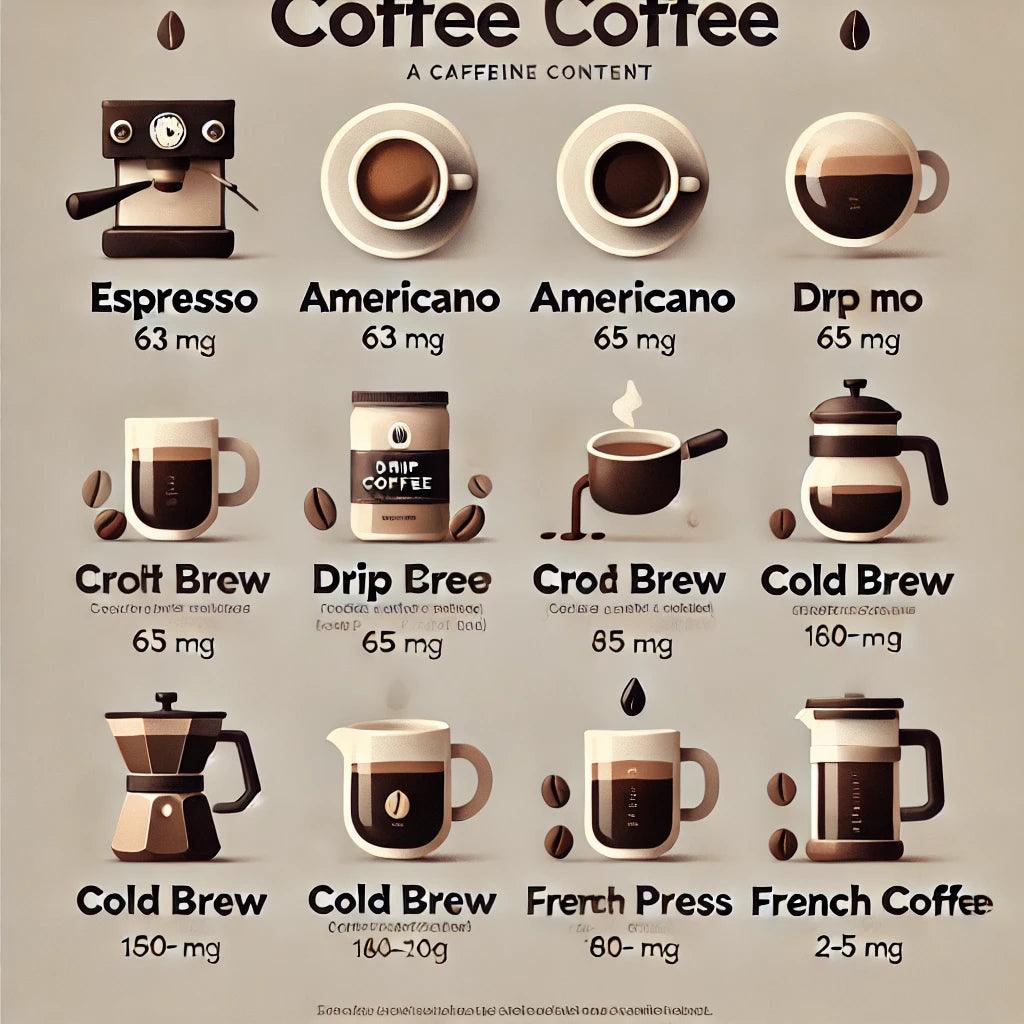How Much Caffeine is in Your Coffee? A Guide to Caffeine Content in Different Coffee Types
By hanxu

Caffeine is the magic ingredient that gives coffee its energizing kick, but not all coffee drinks contain the same amount of caffeine. Depending on the brewing method, bean type, and serving size, caffeine content can vary significantly. In this guide, we’ll explore the caffeine content in various coffee types and provide tips to help you manage your caffeine intake based on your personal preferences.
Factors That Influence Caffeine Content
Before diving into specific coffee types, it’s essential to understand the key factors that influence caffeine levels:
- Type of Coffee Beans: Arabica beans typically contain less caffeine than Robusta beans.
- Brewing Method: Different methods, like espresso or cold brew, extract caffeine in varying amounts.
- Serving Size: Naturally, a larger cup contains more caffeine. For example, a typical 8-ounce (240 ml) coffee has less caffeine than a 12-ounce (355 ml) coffee.
- Roast Level: Lighter roasts tend to have slightly more caffeine than darker roasts, though the difference is usually minimal.
Caffeine Content in Popular Coffee Types
-
Espresso
- Caffeine Content: About 63 mg per 1-ounce (30 ml) shot
- Best For: Those who prefer a small but potent dose of caffeine.
-
Americano
- Caffeine Content: Same as espresso since it’s diluted with water but retains the caffeine. One shot of espresso in an Americano has about 63 mg of caffeine.
- Best For: Those who enjoy a less intense, more sippable coffee with the strength of espresso.
-
Drip Coffee (Standard Brewed Coffee)
- Caffeine Content: Roughly 95 mg per 8-ounce (240 ml) cup
- Best For: Regular coffee drinkers who enjoy a balanced caffeine boost without the intensity of espresso.
-
Cold Brew
- Caffeine Content: Generally between 150–200 mg per 12-ounce (355 ml) serving, though this varies depending on brew strength.
- Best For: People who enjoy a smoother, less acidic coffee that packs a high caffeine punch.
-
French Press
- Caffeine Content: Approximately 80–100 mg per 8-ounce (240 ml) serving, depending on steeping time and coffee-to-water ratio.
- Best For: Coffee lovers who prefer a rich, full-bodied flavor and can handle moderate caffeine.
-
Decaf Coffee
- Caffeine Content: Around 2–5 mg per 8-ounce (240 ml) cup
- Best For: Those who want the coffee experience without much caffeine.
Tips for Controlling Your Caffeine Intake
- Choose Your Brewing Method: Opt for drip coffee or a single shot of espresso if you want a moderate caffeine intake. Cold brew or multiple shots of espresso will increase your caffeine consumption.
- Mind Your Serving Size: Larger drinks have more caffeine, so if you're sensitive, stick to smaller cups or single shots.
- Try Decaf in the Afternoon: If you enjoy the taste of coffee but want to limit caffeine intake later in the day, decaf is an excellent choice.
Quick Caffeine Chart
| Coffee Type | Serving Size | Caffeine Content |
|---|---|---|
| Espresso | 1 oz (30 ml) | ~63 mg |
| Americano | 8 oz (240 ml) | ~63 mg |
| Drip Coffee | 8 oz (240 ml) | ~95 mg |
| Cold Brew | 12 oz (355 ml) | 150–200 mg |
| French Press | 8 oz (240 ml) | 80–100 mg |
| Decaf Coffee | 8 oz (240 ml) | 2–5 mg |
By understanding the caffeine content in your favorite coffee drinks, you can better tailor your coffee choices to your needs, whether it’s for an early morning boost, a mid-day pick-me-up, or a late-night decaf option. And if you’re interested in making cold brew at home for a stronger, smoother coffee experience, check out our collection of cold brewers here.
I'll generate an accompanying image showcasing various coffee types and their caffeine content.
Here’s an infographic summarizing the caffeine content in different coffee types. This visual can be an excellent addition to your blog, helping readers quickly understand caffeine levels across popular coffee choices. Let me know if you'd like any adjustments!
0 comments






















